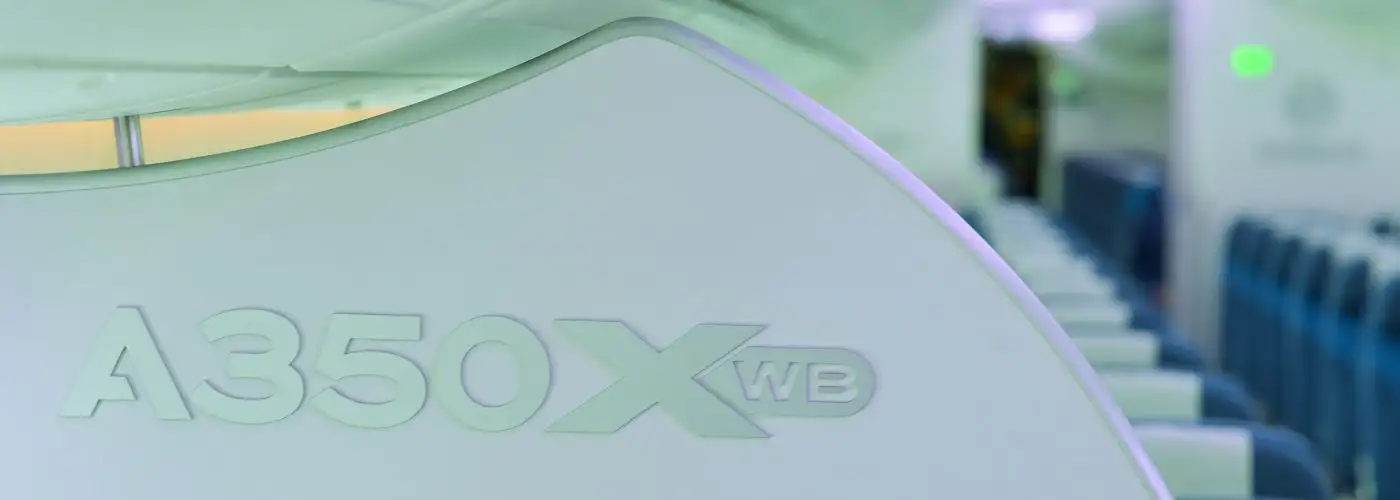Jet lag—the grogginess, dehydration, and general discomfort that follows a long-haul flight, has always seemed unavoidable. Especially now, as airlines pack even more passengers into dry, pressurized cabins and decrease their average seat size. Right?
Maybe not anymore. In a rare move for air travel, Airbus, the same jet manufacturer that proposed stacking plane passengers on top of each other just last year, has rolled out a plane that’s actually designed to mitigate jet lag.
Frequent flyers have been abuzz about Airbus’s new A350 XWB (which stands for extra-wide body) aircraft. These comfort-focused planes are now used by top-ranked, long-haul carriers like Singapore Airlines, Qatar Airways, Thai Airways, Finnair, and TAM.
The model’s new technology includes lowered cabin pressure, a more ambient lighting system, increased in-flight humidity, 18″ seat width, and Rolls Royce engines that are 25 percent quieter. This sounds like a step forward in the fight for flight comfort, especially since studies suggest that dehydration, harsh light, high atmospheric pressure, and lack of sleep all fuel jet lag.
Increased cabin humidity means passengers can leave the electrolyte pills, eye drops, and hand cream at home. Thanks to a cabin pressure of 6,000 feet—2,000 feet lower than standard plane cabin pressure—the in-flight air can be more humid. The XWB also filters in fresh air every so often rather than simply circulating the same stale air. Plus, wide seats and quiet engines make getting some shuteye much easier.
The post-flight difference, according to those who have tested it, is noticeable. Conde Nast Traveler editor Cynthia Drescher says she noticed the difference in air humidity on the XWB’s maiden voyage and could sleep without waking up to a dry mouth. The Boston Globe‘s Christopher Muther reported feeling all-around less fatigued: without the dry skin that a usual long flight would impose, and sans headache.
But it’s not just comfort that sets these planes apart.
The A350 XWB are better engineered to be lighter and more aerodynamic, and thus more fuel-efficient. In a world where sustainability and efficiency are increasingly in demand for both environmental reasons and consumer preference, the XWB could be the answer to keeping customers happy—in more ways than one.
Airbus spent $15 billion to develop the model, and has received over 800 orders for A350 XWBs as of August 2016. Only 30 of these planes are currently in operation, but that will evidently soon change.
These flights will, of course, cost you—economy seats appear to start at prices that are at least a few hundred more dollars than the average plane ticket, depending on the airline and the route, with some appearing to cost twice as much. (Explore some A350 XWB options online at SingaporeAir.com and Finnair.com.) It’s no surprise this new technology is starting out sky-high expensive, but it could become more affordable over time.
So it seems the jet lag-free plane has finally come—and it could be the future of air travel.
More from SmarterTravel:
- How to Look (and Feel) Flawless When You Get Off the Plane
- Pro Tips for Surviving a Long-Haul Flight
- 11 Must-Haves for Your Carry-On Bag
Associate Editor Shannon McMahon writes about all things travel. Follow her on Instagram and Twitter for more insight and adventure.
We hand-pick everything we recommend and select items through testing and reviews. Some products are sent to us free of charge with no incentive to offer a favorable review. We offer our unbiased opinions and do not accept compensation to review products. All items are in stock and prices are accurate at the time of publication. If you buy something through our links, we may earn a commission.
Related
Top Fares From
Today's Top Travel Deals
Brought to you by ShermansTravel
Shop and Save with Country Inns...
Patricia Magaña
 Hotel & Lodging Deals
Hotel & Lodging Deals
$229 -- Chicago: Discounted Rates and...
Francesca Miele
 Hotel & Lodging Deals
$229+
Hotel & Lodging Deals
$229+
$188 -- Honolulu: Save on Oceanview...
Abigail Lamay
 Hotel & Lodging Deals
$188+
Hotel & Lodging Deals
$188+




